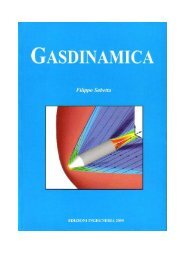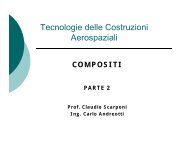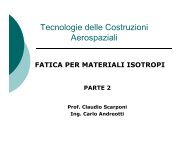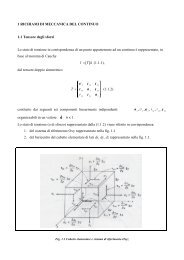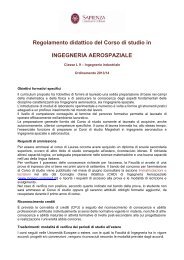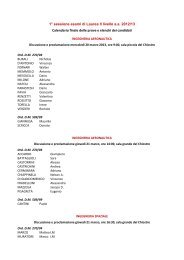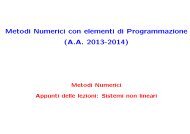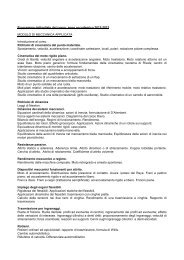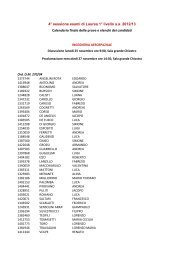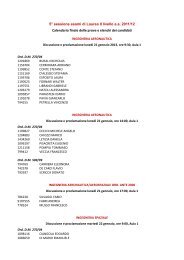You also want an ePaper? Increase the reach of your titles
YUMPU automatically turns print PDFs into web optimized ePapers that Google loves.
416 LIEW ET AL.<br />
Table 4<br />
Summary of results for mission analysis<br />
(24,000 lbf of takeoff weight)<br />
Baseline ITB<br />
Fuel Fuel Fuel Fuel<br />
Mission Alt, used, used, saved, saved,<br />
phases and segments M 0 kft lbf lbf lbf %<br />
1-2: A, warm up 0.0 2 380 347 33 8.7<br />
2-3: E, climb/acceleration 0.875 23 484 475 9 1.9<br />
3-4: Subsonic cruise climb 0.9 42 510 501 8 1.7<br />
5-6: Combat air patrol 0.697 30 715 703 13 1.8<br />
6-7: F, acceleration 1.09 30 248 244 4 1.6<br />
G, supersonic —— —— —— —— —— ——<br />
6-7: Penetration 1.5 30 1778 1716 62 3.5<br />
7-8: I, 1.6M/5-g turn 1.6 30 415 401 14 3.3<br />
7-8: J, 0.9M/5-g turn 0.9 30 297 292 5 1.8<br />
7-8: K, acceleration 1.2 30 226 225 1 0.5<br />
8-9: Escape dash 1.5 30 520 503 16 3.1<br />
10 —— —— —— —— —— ——<br />
11: Subsonic cruise climb 0.9 48 462 458 4 0.9<br />
12 —— —— —— —— —— ——<br />
13: Loiter 0.355 10 628 625 3 0.5<br />
Total —— —— 6664 6490 173 2.6<br />
For the following mission study, only case A is considered. For<br />
simplicity, only critical mission phases and segments are selected.<br />
Each selected mission leg is judged to be critical because it has<br />
a high fuel consumption and is an extreme operating condition. 10<br />
In each mission leg, the ITB engine is operating at partial throttle<br />
settings to avoid burning extra fuel as previously discussed.<br />
Table 4 contains a summary of the mission performance of ITB<br />
engine (case A) as compared to baseline engine in term of fuel consumption.<br />
Each aircraft has an initial takeoff weight of 24,000 lbf.<br />
It is found that ITB engine uses less fuel in all phases. Particularly,<br />
the fuel consumption in the warm-up (1-2) phase is significantly<br />
less. This calculation also shows that ITB engine consumes about<br />
2.6% less fuel for all of those selected critical mission legs, which<br />
ensure the fuel efficiency of an ITB engine over the baseline engine.<br />
To get an even better fuel consumption, one might want to return<br />
to the on-design cycle analysis 2,3 and choose other reference-point<br />
engines for further investigation.<br />
Conclusions<br />
A performance-cycle analysis of a separate-flow and two-spool<br />
turbofan with ITB has been presented. The mathematical modeling<br />
of each engine component (e.g., compressors, burners, turbines,<br />
and exhaust nozzles), in terms of its operating condition, has been<br />
systematically described. Results of this study can be summarized<br />
as follows:<br />
1) ITB engine at full throttle setting has enhanced performance<br />
over baseline engine.<br />
2) ITB operating at partial throttle settings will exhibit higher<br />
thrust at lower S and improved thermal efficiency over the baseline<br />
engine.<br />
3) Mission study ensures the ITB engine’s advantage of saving<br />
fuel over the baseline engine.<br />
Acknowledgment<br />
The authors would like to thank NASA John H. Glenn<br />
Research Center at Lewis Field for its financial support under Grant<br />
NAG3-2759.<br />
a)<br />
b)<br />
Fig. 6 Partial-throttle performance of turbofan engine (case B) at<br />
altitude of 10 km, π fR = 2.2, π cR = 25, T t4R = 1550 K, T t4.5R = 1450 K,<br />
ṁ 0R = 540 kg/s, and α R = 4.0.<br />
Mission Analysis<br />
A systematic mission study of the fuel consumption is performed<br />
to reveal the advantage of saving fuel by adding ITB. However, at this<br />
preliminary design phase the engine manufacturer’s published data<br />
are often unavailable; therefore, the off-design engine model like this<br />
one can be used to give a preliminary estimate of fuel consumption<br />
in each mission phase. 10 A 5% installation loss is accounted to give<br />
the mission analysis fuel consumption.<br />
References<br />
1 Zucrow, M. J., Aircraft and Missile Propulsion: Volume II, Wiley, New<br />
York, 1964, pp. 52, 53.<br />
2 Liew, K. H., Urip, E., Yang, S. L., and Siow, Y. K., “A Complete Parametric<br />
Cycle Analysis of a Turbofan with Interstage Turbine Burner,” <strong>AIAA</strong><br />
Paper 2003-0685, Jan. 2003.<br />
3 Liew, K. H., Urip, E., and Yang, S. L., “Parametric Cycle Analysis of a<br />
Turbofan Engine with an Interstage Turbine Burner,” Journal of Propulsion<br />
and Power, Vol. 21, No. 3, 2005, pp. 546–551.<br />
4 Liu, F., and Sirignano, W. A., “Turbojet and Turbofan Engine Performance<br />
Increases Through Turbine Burners,” Journal of Propulsion and<br />
Power, Vol. 17, No. 3, 2001, pp. 695–705.<br />
5 Sirignano, W. A., and Liu, F., “Performance Increases for Gas-Turbine<br />
Engines Through Combustion Inside the Turbine,”Journal of Propulsion and<br />
Power, Vol. 15, No. 1, 1999, pp. 111–118.<br />
6 Vogeler, K., “The Potential of Sequential Combustion for High Bypass<br />
Jet Engines,” Proceedings of the International Gas Turbine and Aeroengine<br />
Congress and Exhibition, June 1998; also ASME 98-GT-311, June 1998.<br />
7 Oates, G. C., Aerothermodynamics of Gas Turbine and Rocket Propulsion,<br />
2nd ed., <strong>AIAA</strong> Education Series, <strong>AIAA</strong>, Washington, DC, 1988,<br />
pp. 277–296.<br />
8 “Gas Turbine Engine Performance Station Identification and Nomenclature,”<br />
Aerospace Recommended Practice (ARP) 755A, Society of Automotive<br />
Engineers, Warrendale, PA, 1974.<br />
9 Mattingly, J. D., Elements of Gas Turbine Propulsion, McGraw–<br />
Hill, New York, 1996, pp. 18–31, 114–123, 240–246, 256–299, 346–361,<br />
392–405.<br />
10 Mattingly, J. D., Heiser, W. H., and Pratt, D. T., Aircraft Engine Design,<br />
2nd ed., <strong>AIAA</strong> Education Series, <strong>AIAA</strong>, Reston, VA, 2002, pp. 55–92,<br />
139–162, 577–587.<br />
11 Liew, K. H., Urip, E., Yang, S. L., Mattingly, J. D., and Marek, C. J.,<br />
“Performance (Off-Design) Cycle Analysis for a Turbofan Engine with<br />
Interstage Turbine Burner,” NASA-TM-2005-213658, July 2005.



